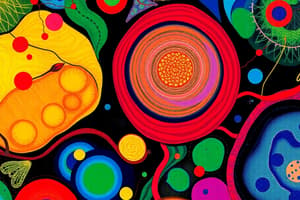Podcast
Questions and Answers
What does the cell theory state about cells?
What does the cell theory state about cells?
- All cells are identical in function and structure.
- Cells can arise from non-cellular materials.
- Cells are randomly generated in organisms.
- All living organisms are composed of cells. (correct)
Which of the following describes the role of DNA?
Which of the following describes the role of DNA?
- DNA is a type of protein energy source.
- DNA carries genetic information. (correct)
- DNA can only be found in prokaryotic cells.
- DNA is responsible for cellular respiration.
How does natural selection contribute to evolution?
How does natural selection contribute to evolution?
- It drives species to adapt through genetic variations. (correct)
- It prevents species from changing over time.
- It promotes uniformity across all species.
- It eliminates all mutations in species.
What distinguishes plant cells from animal cells?
What distinguishes plant cells from animal cells?
Which of the following statements is true regarding ecosystems?
Which of the following statements is true regarding ecosystems?
Flashcards are hidden until you start studying
Study Notes
Key Concepts in Biology
Cell Theory
- All living organisms are composed of cells.
- The cell is the basic unit of life.
- All cells arise from pre-existing cells.
Genetic Material
- DNA (Deoxyribonucleic Acid) carries genetic information.
- Chromosomes are structures within cells that contain DNA.
- Genes are segments of DNA that code for proteins.
Evolution
- Natural selection drives evolution.
- Species adapt over time through genetic variations.
- Common descent indicates all species share a common ancestor.
Homeostasis
- The ability of organisms to maintain stable internal conditions.
- Mechanisms include feedback systems (positive and negative).
Ecology
- Study of interactions between organisms and their environment.
- Ecosystems comprise living (biotic) and non-living (abiotic) components.
- Food chains and webs illustrate energy flow.
Classification of Life
- Domain: Archaea, Bacteria, Eukarya.
- Kingdoms: Protista, Fungi, Plantae, Animalia.
- Organisms are classified based on shared characteristics.
Photosynthesis and Cellular Respiration
- Photosynthesis occurs in chloroplasts, converting light energy to chemical energy (glucose).
- Cellular respiration is the process of breaking down glucose for energy (ATP).
Animal and Plant Cells
- Animal cells lack a cell wall and chloroplasts; have lysosomes.
- Plant cells have a cell wall, chloroplasts, and a central vacuole.
Systems of the Human Body
- Major systems include circulatory, respiratory, digestive, nervous, and reproductive.
- Each system has specific functions and works collaboratively to maintain life.
Microbiology
- Study of microorganisms (bacteria, viruses, fungi, protozoa).
- Important in ecology, human health, and disease.
Biotechnology
- Use of living systems to develop products (e.g., genetic engineering, CRISPR).
- Applications include medicine, agriculture, and environmental management.
Cell Theory
- All living things are made up of one or more cells.
- Cells are the basic unit of structure and function in all living organisms.
- New cells can only arise from pre-existing cells, supporting the idea that life arose from previous life.
Genetic Material
- DNA, a molecule shaped like a double helix, carries all the organism's genetic information.
- This information is organized into structures called chromosomes, which are found within the nucleus of every cell.
- Genes are short sections of DNA that hold instructions for building specific proteins, influencing traits, and functioning.
Evolution
- Natural selection is the primary mechanism of evolution, based on the survival and reproduction of the fittest individuals with advantageous traits.
- Over time, species change as a result of genetic variations that arise from mutations and environmental pressures.
- All living organisms share a common ancestor, tracing back to the origin of life, demonstrating the interconnectedness of all life on Earth.
Homeostasis
- Organisms maintain a stable internal environment despite changes in external conditions.
- There are mechanisms that regulate and adjust these internal conditions, such as feedback systems (positive and negative).
- These systems, like a thermostat regulating temperature, help ensure conditions stay within the optimal range for optimal function.
Ecology
- The study of interactions between living organisms and their environment.
- Ecosystems are complex communities made up of biotic (living) and abiotic (non-living) components.
- Food chains and webs illustrate the flow of energy within an ecosystem, showing relationships between producers, consumers, and decomposers.
Classification of Life
- Three domains: Archaea, Bacteria, and Eukarya encompass all life forms.
- Within Eukarya, there are four kingdoms: Protista, Fungi, Plantae, and Animalia.
- This classification system arranges organisms based on shared characteristics, helping us understand evolutionary relationships and relationships between species.
Photosynthesis and Cellular Respiration
- Photosynthesis occurs within chloroplasts, using light energy to convert carbon dioxide and water into glucose (sugar) and oxygen.
- Cellular respiration uses glucose for energy production, breaking it down to produce ATP (adenosine triphosphate), the energy currency of cells.
Animal and Plant Cells
- Plant cells have a cell wall, chloroplasts, and a large central vacuole that stores water and nutrients.
- Animal cells lack these features, instead having lysosomes, organelles that break down cellular waste and debris.
Systems of the Human Body
- The body comprises multiple systems, each with a specific function for maintaining life.
- Major systems include the circulatory, respiratory, digestive, nervous, and reproductive systems.
- These systems work together in a coordinated and intricate way to ensure the body's wellbeing.
Microbiology
- The study of microorganisms, including bacteria, viruses, fungi, and protozoa.
- These organisms play crucial roles in various ecosystems, impacting human health and disease, as well as having applications in industries like food production and pharmaceuticals.
Biotechnology
- Utilizes living organisms or their components to create products with commercial applications.
- Techniques like genetic engineering and CRISPR-Cas9 enable modifications to an organism's DNA for advancements in medicine, agriculture, and environmental management.
Studying That Suits You
Use AI to generate personalized quizzes and flashcards to suit your learning preferences.




